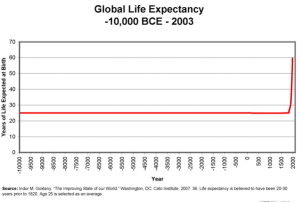Life Expectancy Gains Are Slowing, Especially in the U.S.
Modern medicine has undeniably extended the lives of people around the world, but, recently, a few data points have begun to muddle the clean upward trends. Gains in life expectancy have begun to slow, particularly in the United States.

Share
There’s a tendency among techno-optimists to point to charts that show an unequivocal increase in life expectancy in recent history. For example:
Modern medicine has undeniably extended the lives of people around the world, but, recently, a few data points have begun to muddle the clean lines of such charts when looking for a little more detail. Gains in life expectancy have begun to slow.
The United States, especially, lags behind. We have our growing income disparity to thank for pulling down the national average, according to a county-by-county analysis done by the University of Washington’s Institute for Health Metrics and published in the Lancet.
“There are counties in the U.S. where a woman or man can live close to the top life expectancy in the world, and we have counties in the U.S. where life expectancy is similar to what we see in Africa. That disparity is causing gains to slow down so that we’re not keeping up with our peers,” Ali Mokdad, of the Institute for Health Metrics and Evaluation, told Singularity Hub.
“Eighty percent of the counties in the U.S. have life expectancy lower than that of Cuba,” he added.
Comparing national averages doesn’t paint quite as dire a picture. Between 1990 and 2011, U.S. life expectancy at birth grew 5 percent from 75 years to 79. Between 1970 and 1990, infants also gained five years of expected life after starting at 70.
Other developed countries made slightly better progress. In France, life expectancy rose by 8 percent from 1970 to 1990 and by 5 percent from 1990 to 2011. In Japan, the world’s leader in life expectancy, babies born in 1970 were expected to live 72 years on average. That number grew by nearly 10 percent to 79 in 1990 before slowing to a 5 percent growth rate to stand at 83 in 2011. Norway’s growth parallel’s the United States’, progressing steadily from 74 in 1970 to 81 in 2011.
Still, residents of nearly all European countries can expect current newborns to live longer than those born in the U.S., as can Kuwait, South Korea, Israel and Andorra.
In the developing world, life expectancy grew much faster during the same period, but also slowed somewhat in the two decades following 1990 relative to the two before.
Babies born in India and Indonesia saw their predicted life spans grow by nearly 20 percent between 1970 and 1990. Since then, India, Indonesia, China and Brazil have all seen life expectancy extend by 10 - 12 percent.
According to Mokdad, life expectancy depends on many factors: income and education, access to health care — which includes both physical proximity and affordability — and the quality of medical care. But most important of all is the element least affected by science and technology: lifestyle. And while people in developing countries have more opportunity to exercise and eat a full complement of fruits and vegetables, they are also more likely to become sick with diseases related to eating too much salt, cholesterol and sugar.
High-level statistics also hint at some of these tradeoffs. Life expectancy doesn’t simply rise as a country gets wealthier, for example. The World Health Organization breaks countries into four income categories, and between the poorest and the next poorest, life expectancy falls before rising through the other categories.
Be Part of the Future
Sign up to receive top stories about groundbreaking technologies and visionary thinkers from SingularityHub.


Imagine living in a rural, agrarian society. There are few roads and few health clinics. As the country develops, construction happens hurly-burly, bringing pollution and industrial accidents. There are roads, but they’re not necessarily safe and most citizens, if they have cars, are new to driving. Smoking also tends to increase in countries as their economies see major expansions (the U.S. in the 1950s and 60s and China in the 1970s and ’80s). Life expectancies fall until health care and government regulations catch up and smoking declines. Then they go up as the benefits of living in a wealthier country manifest themselves.
So, what about the future — will gains in life expectancy shoot up again as techno-optimists like Ray Kurzweil posit? Not according to the WHO. The organization’s morbidity predictions for 2015 - 2030 don’t indicate that areas of medicine currently making strides will push longevity trend lines in developed countries back up.
Heart disease, linked to diet, is the single largest killer in the world. In upper-middle income countries, the WHO predicts that deaths caused by it will fall significantly. But in upper income countries, virtually no progress will be made against heart disease.
Okay, but surely we will make progress against cancer, you may say. Alas, not according to WHO statistics.
While medical advances have brightened the prognoses for many cancer patients, the WHO predicts that cancer will continue to account for about half of all deaths in upper-middle income and upper income countries. Alzheimer’s and Parkinson’s diseases are on a course to claim more lives.
Statistics do reflect some unqualified medical successes with effects big enough to push national life expectancy averages up significantly.
Major advances in the treatment of HIV have resulted in dramatically longer life spans in many African countries. To take but one example, a baby born in Botswana in 1990 would live, on average, 65 years. But 10 years later, a baby was only expected to live 49 due largely to the HIV epidemic. In 2011, life expectancy had made up its losses and gained a year to boot.
Experts expect still more progress on infant mortality, which has been the rock star of longevity data, in both developed and developing countries. Since 1970, deaths of those under age four have fallen by more than 70 percent worldwide — and, according to one study, that dropoff accounts for half of all gains in life expectancy.
So what do these numbers reveal about the role of technology in improving health? The smartphone may be the most powerful tool in a doctor’s bag, Mokdad said. Simply following up with patients to ensure that they follow doctor’s orders will improve and extend more lives than a cutting-edge medical breakthrough, he said.
Cameron received degrees in Comparative Literature from Princeton and Cornell universities. He has worked at Mother Jones, SFGate and IDG News Service and been published in California Lawyer and SF Weekly. He lives, predictably, in SF.
Related Articles

This Light-Powered AI Chip Is 100x Faster Than a Top Nvidia GPU

This Week’s Awesome Tech Stories From Around the Web (Through December 20)

Data Centers in Space: Will 2027 Really Be the Year AI Goes to Orbit?
What we’re reading




